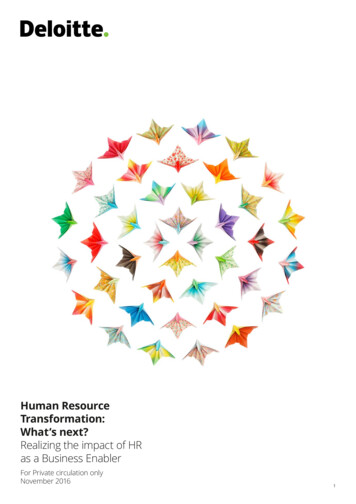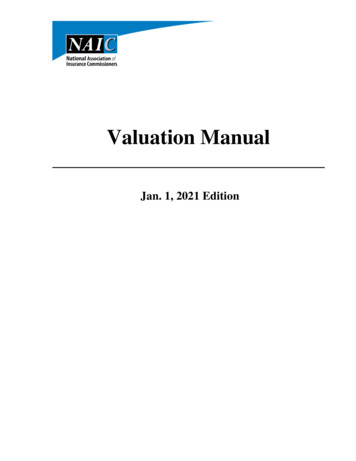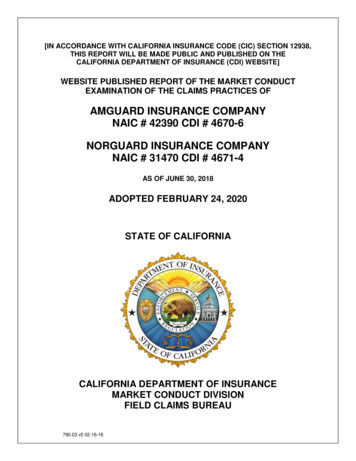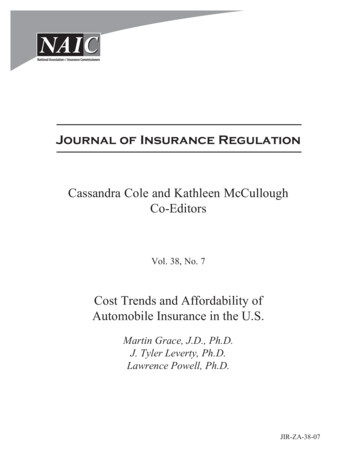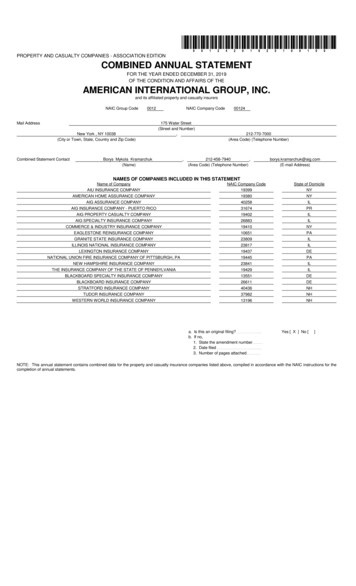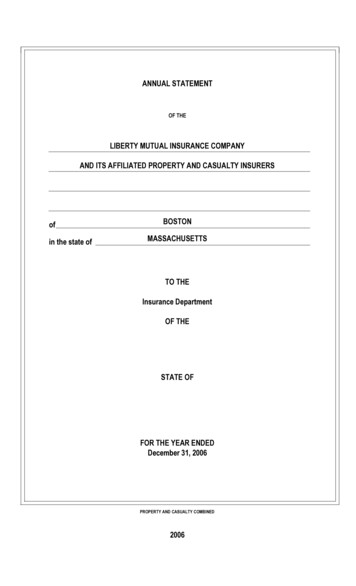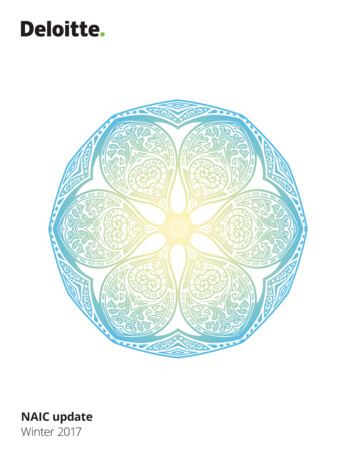
Transcription
NAIC updateWinter 2017
IAIS update: Summer 2017ContentsRegulators celebrate a year of accomplishments1RBC, AG43 changes exposed for discussion2Big Data working group wants feedback on regulatory framework4Consumer, industry disagree on antifraud data charge5Best interest standard moves a step closer6International organization’s new head conducts dialog with NAIC stakeholders7Guaranty fund changes for LTC, HMOs8Covered agreement to be discussed at hearing9In brief10Health care update11Accounting update122
NAIC update Winter 2017Regulators celebrate ayear of accomplishmentsHONOLULU, HAWAII — Storm cloudscovered the horizon, unloading tropicalrain almost every day of the fall meetingof the National Association of InsuranceCommissioners (NAIC). Metaphorical stormclouds also shaded the future, with theFriday morning meetings interrupted bythe first sounding of the Aloha State’snuclear warning sirens since the end ofthe Cold War.By contrast, the mood inside the meetingseemed almost jovial, with commissionersenjoying the kind of clarity on the futureof state insurance regulation not seensince the enactment of the Dodd-FrankAct, when state regulators might haveconsidered their authority under threatof federal preemption.Just as the storm clouds gave way tosunshine, highlighting the stunning naturalbeauty of the 50th state outside, thelatest report from the US Department ofTreasury had reaffirmed the primacy of stateinsurance regulation. The NAIC President,Wisconsin Insurance Commissioner TedNickel, called the Treasury report “ themost explicit endorsement of stateregulation from the Treasury Departmentwe’ve ever seen.”“I‘d like to think the NAIC has establishedor re-established its footing as a leader oninsurance regulatory issues this year,” Nickelsaid at the opening session. Among theorganization’s signature accomplishmentsduring Nickel’s year as president was theadoption of the Insurance Data SecurityModel Act, a framework for cybersecurity forregulated entities.This was one of a number of NAIC initiativesdesigned to position regulators toproperly integrate and supervise the newtechnologies commonly grouped togetheras insurtech and regtech. “I suspect at somepoint in the future we will look back at thisperiod as the time when new technologies,new market disruptors, and new innovationsbegan to make their mark on insurance, theslow death of tradition in insurance rapidlyaccelerated, and we may struggle to recallwhat our sector was like before,” Nickel said.Engagement with international regulatorscontinued, with new InternationalAssociation of Insurance Supervisors(IAIS) Secretary-General Jonathan Dixonaddressing various meetings, and NAICcommissioners explaining the impactof recently agreed-to Insurance CapitalStandard (ICS) processes.Now regulators can shift their focus to thespring meeting scheduled for Milwaukee,Wisconsin in March 2018. The weather inMilwaukee in March may be a bit differentfrom that in Hawaii in December, but theissues affecting the industry are likely toremain consistent. Expect concerns suchas the future of the Affordable Care Actand the impact of changes in the tax lawto be discussed. The NAIC is also expectedto unveil its new three-year strategic plan,maintaining the focus on positioning theorganization for the challenges ahead.Nickel and the NAIC looked to the futurein other ways as well. Top items addressedincluded potential changes to ActuarialGuideline 43 affecting variable annuitiesand new sales standards for all annuities.Another major outcome involved thewidening of the funding sources for guarantyfunds, a reflection of ongoing concern withthe long-term care (LTC) insurance segment.1
NAIC update WInter 2017RBC, AG43 changesexposed for discussionThe Variable Annuities (E) Working Groupheld a four-hour meeting during whichrepresentatives from a consultant hired bythe group presented suggested changesto Actuarial Guideline XLIII—CARVM forVariable Annuities (AG43) and to life riskbased capital (RBC C3 Phase II) that couldhave significant impact on sellers of variableannuities, inasmuch as they would affectin-force blocks of business.Even before the presentation,representatives of the American Academyof Actuaries (AAA) expressed concernto working group members about whatthey considered the difficulty of providingstakeholder input on this topic thusfar. One representative asked that theproposal not be considered final, but ratherjust beginning, with a longer-than-usualexposure period to April 30, 2018.“We do expect there to be a dialogue,” theworking group chair told the meeting, butalso suggested there were time constraints,including the length of the consultants’contract and the desire to have a finishedproduct no later than the summer 2018national meeting. The document was later2exposed for comment until March 2, 2018.There will be an all-day meeting of theworking group at the spring meeting inMilwaukee where comments willbe discussed.AG43 and C3 Phase II were designed asa principles-based approach to settingreserves and regulatory capital levels forvariable and certain other equity-basedannuity products. Reserves and capitalare based on projections of product cashflows over stochastic economic scenarioswith a “standard scenario” floor anddriven by changing current and projectedeconomic conditions.C3 Phase II and VA CARVM wereimplemented around the time of theeconomic crisis, and it became apparentthat adjustments to the methodology maybe considered. The assets required underthe initial requirements tended, in somecases, to become excessive under extremeeconomic conditions. Additionally, somehedge programs designed to hedge the realworld economics of the products did notreflect the same benefits in the statutoryframework.In 2015, the NAIC commissioned an effort toidentify potential changes to this statutoryframework, as companies had begun touse captive reinsurance transactions torelieve the statutory requirements of theseproducts. Proposed changes have beenevaluated through two quantitative impactstudies (QIS) to date. QIS I focused onindustry issues such as hedging mechanics(the increase in required capital due toextensive hedging, suboptimal hedgingstrategies that produce more favorablestatutory requirements, hedge costs in risingscenarios) and disconnects between marketbased capital requirements and actualmarket risk retained.Following QIS II, there have been a listof 28 recommendations for updates tothe methodology, including changes tothe stochastic amount (conditional tailexpectation, or CTE), the standard scenarioamount, the C3 charge itself (difference
NAIC update Winter 2017between statutory reserve and CTE 95),disclosure requirements, and other topics.The NAIC intends the recommendationsto: better align statutory calculations witheconomic risk, reducing disincentivesto hedge; provide better comparabilitybetween companies; and simplify thecalculations and interpretation of results.The organization also sought to mitigate oreliminate the need for the use of captives.QIS II results indicate that hedging maystill increase total assets required in a lowinterest rate environment, which may drivecompanies to reduce hedging in certainsituations. Also, recommendations to therecalibration of the scenario generatormay increase volatility in separate accountinvestment returns.Some at the meeting argued that evaluatingthe results of the proposed changes maybe difficult considering the lack of availableinformation from the NAIC. A representativeof the consultants explained that there wasextremely limited information available fromthe quantitative impact study by designbecause of confidentiality issues, and theNAIC would be working with the AmericanCouncil of Life Insurers (ACLI) to determinewhat may be released.Speakers also had issues with the use ofthe proprietary scenario generator, andcalled for greater disclosure of “some of thethinking that went into this.”One stakeholder expressed concernthat some companies would have zeroreserves in today’s economic environment.Regulators responded that it could be thosecompanies have embedded profits, notcosts, in their portfolio, and, thus, this wouldbe appropriate.A representative of the ACLI called onregulators to initially expose a list ofquestions that they would like feedback onconcerning this big overhaul, then proceedto make sure the text of the documentmatches those desires. He suggestedthat there should be a discussion as towhat to expose, and it should not be thepresentation by consultants.A representative of the AAA saidher interpretation was that therecommendation would represent anincreased role for RBC, and would move USinsurance regulation away from the currentrole of RBC as signaler, and perhaps closerto capital requirement. The representativealso warned that any changes to calibrationcriteria being made relative to variableannuities may have consequences forother products, expressing concern aboutpossible downstream efforts.The chair responded by proposing to exposethe presentation and the redline documentuntil March 2—which was accepted by thecommittee—and schedule topic calls anda one-day meeting immediately before theMilwaukee national meeting.3
NAIC update WInter 2017Big Data working groupwants feedback onregulatory frameworkRegulatory oversight of insurers’ use ofconsumer data was a top issue at themeeting of the Big Data (EX) WorkingGroup. The working group chair notedthat no comments have been received onthe proposed framework for regulation,however certain items had just been addedto the agenda, so the document wouldremain open for comments until January 12.The group is charged with reviewing “currentregulatory frameworks used to overseeinsurers’ use of consumer and noninsurancedata. If appropriate, [it] recommendsmodifications to model laws/regulationsregarding marketing, rating, underwritingand claims, regulation of data vendors andbrokers, regulatory reporting requirements,and consumer disclosure requirements.”One regulator suggested that a parallelto the supervisory oversight frameworkfor credit reports be applied to the use ofthird-party vendors in underwriting andother areas. Regulators also suggested thatdisclosure and the ability to questionif denied insurance should be availableto consumers.Another regulator suggested looking atdata variables that conflict with state law.However some regulators disagreed, sayingit was a separate issue. The working groupwill survey states for specific prohibitions forauto and homeowners lines.Another regulator asked about the workinggroup’s plans for life insurance—especiallythe issue of accelerated underwriting—butthe working group noted that it had chosen4to start with the property and casualty(P&C) sector first and then move on tolife insurance.Consumer representative Birny Birnbaumtold the working group it should alsoconsider claims and price optimization,and the algorithm bases for these.Questions for consideration includedwhether algorithms discouragedconsumers from cost mitigation, if theywere accurate or discriminatory, andwhat rights should a consumer have overconsumer-generated data.Data portability was also a concern, hesaid, adding that the lack of regulatory datacollection and the ability to assess insurercorrectness were other topics that shouldbe reviewed.The working group also heard a report onthe progress on the NAIC’s efforts to reviewcomplex models. It was told that the NAICwill survey state needs regarding complexmodels and predictive analytics and reportback to the working group. That documentwill be circulated for discussion, with theexpectation being that best practices wouldbe created for filing requirements.Discussion issues identified by theworking group:Issues raised by consumers Are there adequate privacy standardsfor the use of consumer data? Do consumers have dataownership rights? Should insurers be required to notifyconsumers regarding the use of their data,similar to notification requirements of theFair Credit Reporting Act? Should consumers have the right tocontest data and request correctionsto data? Are there issues specific to a particular lineof insurance?Issues raised by industry Do insurers and data vendors haveappropriate confidentiality protectionsof intellectual property when submittingmodels to regulators? Are there regulatory standards that arebarriers to the use of data by insurers? Are there issues specific to a particular lineof insurance?Issues raised by regulators Do regulators have appropriate access toinsurers’ models through the current ratefiling process? Are there any data variables that shouldbe prohibited? Should there be specific levels ofcorrelation and/or causality forrating variables? Are regulators seeing additional risksegmentation, and is this having a positiveor negative impact on consumers? Is there a need for additional regulatoryoversight of data vendors? Are there issues specific to a particular lineof insurance?
NAIC update Winter 2017Consumer, industrydisagree on antifrauddata chargeA proposed amended charge to addressinnovation and technology drew conflictingresponses at the Antifraud (D) TaskForce meeting.Consumer representative Birnbaumsuggested adding language that algorithmsneed to be reviewed for potential biasand the responses coordinated with theBig Data Working Group. Various industrygroups opposed this, calling the new chargeredundant and suggesting it properlybelonged before Big Data.Birnbaum responded that the charge wasimportant and necessary since claims, aswell as underwriting, relied on algorithmswhich are susceptible to bias, eitherintentional or unintentional. If the data forthe thing you are trying to predict showshistoric bias, then the prediction would alsoinclude bias, Birnbaum said.Birnbaum went on to say that machinelearning—algorithms changing themselveswithout any human interaction—raisedaccountability concerns. He said the industrygroups were mischaracterizing the Big DataWorking Group charges, and the proposedcharges do not overlap.Birnbaum added that the Big Data WorkingGroup would not be looking at antifraud atleast for a while, and that by looking at thespecifics, this group could help inform theBig Data Working Group’s activities. Industrygroups strongly disagreed with Birnbaum.The task force tabled any change pendinga joint phone call with the Big Data WorkingGroup at which stakeholders could makepresentations. The task force will then makeits decision.Photo courtesy of the NAIC5
NAIC update WInter 2017Best interest standard movesa step closerA draft of proposed revisions to theSuitability in Annuity Transactions ModelRegulation (#275) took center stage atthe meeting of the Annuity Suitability (A)Working Group. There seemed to be someconsensus among industry and regulatorson a new best interest standard for annuitysales, however concerns were expressed bysome, including producer representatives.A New York regulator said that the proposedbest interest standard was not strongenough, and should be withdrawn andstrengthened. The committee chair notedthere was nothing that would stop anindividual state from taking a model andmaking it stronger in its particular state.New York also reiterated its belief that themodel should apply to life insurance.New standards would include broadcompensation disclosure and recordretention mandates, with all involvedworking in the best interest of theconsumer. The comment period runsuntil January 22, 2018. The working groupplans to then reconvene, review commentsreceived, and vote. The goal is to have arecommendation for the Life Insurance andAnnuities (A) Committee at the NAIC’s springmeeting in March.Numerous stakeholders had their say.Consumer representative Birnbaum askedif the intent of the model was to change thenature and/or type of annuity sales, andif yes, how would that be monitored. Thechairman replied that annuity sales hadalready been fundamentally changed, andthe working group’s goal was to weed outthe problems of the past.Reviewing the proposed Suitability and BestInterest Standard of Conduct in AnnuityTransactions Model Regulation, somesuggested that best interest should includesuitability, so there was no need for both inthe proposed new title. However NAIC staffinformed the working group that suitabilitywas kept in deference to state laws thatalready defined suitability, and becausethere were many other items referencingthe NAIC suitability law.6An ACLI representative said if the goalis uniform and consistent regulationacross all platforms, he saw much thatwas encouraging in the draft. Howeverhe still had questions about definitionsand compensation, including a 3 percentcompensation disclosure standard listedin the draft. So too did a producergroup representative.The chair explained that the idea was his,and was intended to create a safe harbor forindustry. He noted that the exact numbermay not be the correct number and he wasopen to discussion, but wanted a threshold.He said the idea was to identify what shouldbe considered a reasonable commission.The producer representative agreed thatconcern could be addressed in editing as hefound the safe harbor concept positive.Another producer group representativewas less positive, asking if the workinggroup could be moving too quickly towardsa proposed April date. The document aswritten would face industry opposition inmany states and “likely strong oppositionby legislators,” he said. He called thecompensation disclosure mandates toobroad and very concerning, and said thebest interest definition should be tweaked.“Conceivably this needle could bethreaded, but it’s a very narrow path,” therepresentative said, adding that his groupwould provide written input. The chairsolicited such input from all stakeholders.A representative of the Insured RetirementInstitute (IRI) flagged certain specifics,including issues with the control of thirdparty distribution. He expressed uncertaintyabout whether the suitability model was theright place to include training standards.
NAIC update Winter 2017International organization’snew head conducts dialogwith NAIC stakeholdersNew IAIS Secretary-General Jonathan Dixontold the IAIS stakeholder gathering at theNAIC meeting that he was glad to be joiningthe organization and NAIC attendees at “aninflection point,” as the conclusion of theIAIS’s work on systemic risk in the ICS nears,but new challenges emerge. Dixon citedfintech, cybersecurity, sustainability, andclimate risk as among the emerging areasof focus for the international insurancestandard setter.Briefing attendees on his organization’swork, Dixon told the crowd there would bea midyear consultation on ComFrame in itsentirety in 2018, and that ComFrame was onschedule for mid-2019 adoption.Dixon said that ICS v 1.0 went into extendedfield testing in July with 50 volunteers,and the IAIS is now analyzing results. TheKuala Lumpur ICS v 2.0 agreement on thetimetable and various other measures wasreached in response to calls for clarity frommembers and stakeholders as to whatthe implementation of ICS v 2.0 meant inpractice, he said.He reviewed the current timetable forICS v 2.0, which included confidentialreporting for five years, and 2025implementation of the ICS as a prescribedcapital requirement (PCR). The IAIS iscontinuing to collect stakeholder feedback,including at a January meeting in Nashville.Dixon said time was running short and theIAIS needed input from all stakeholders.Addressing financial stability issues, Dixonsaid the IAIS had adopted a new work planfor systemic risk in February 2017, and wasworking on improving the global systemicallyimportant insurer (G-SII) methodology,achieving cross-sector consistency withbanking, and on an activity-based approach(ABA) to systemic risk management. Hesaid the IAIS would publish an interimconsultation paper on ABA, hopefully by theend of 2017, with a final consultation papersometime in 2018.There will be a “more substantive”stakeholder meeting on ABA, probably inLondon sometime in January or February,Dixon said.Consumer representative Birnbaum askedabout what he saw as a disparity betweenthe focus on finance and on marketregulation at the IAIS. Dixon replied thatthe IAIS had focused a lot of attention onfinancial stability issues after the financialcrisis, but the hope was that as theymanaged those deliverables, they would beable to start rebalancing. Market conduct isa big part of the fintech focus, Dixon said.A representative of the Property CasualtyInsurance Association of America (PCI) calledon the IAIS to increase stakeholder input atthe working group level.Among other plans, the IAIS hopes to launcha fintech forum for supervisors in 2018.This would help enable discussions onalgorithms and artificial intelligence, amongother issues. An application paper shouldbe published next year on good supervisorypractices on cyber risk and cybersecurity,and the organization also planned the 2018development of lessons for supervisorson climate change, sustainability, andfinancial disclosure.Dixon told the audience he sawimplementation and assessment ofsupervisory standards and principles asthe core of the IAIS mission.7
NAIC update WInter 2017Guaranty fund changes forLTC, HMOsThe Financial Condition (E) Committeeapproved changes to the guaranty fundsystem’s long-term care assessment basethrough changes to the Life and HealthInsurance Guaranty Association Model Act(#520). Assessments will now be split 50–50between life and health, with HMOs beingadded to health. Additionally, there will nowbe coverage for HMO delinquencies.Photo courtesy of the NAIC8Noting objections from one HMO, FinancialCondition Committee Chair and MaineInsurance Commissioner Eric Cioppa saidthose objections had already been reviewedby regulators. He said that regulatorsstarted this process by looking at severalalternatives and all were debated. Headded that the 50–50 split provided a moreequitable distribution of the assessmentas opposed to a snapshot in time of theassessment base.Consumer, health, and life sector groupsall spoke in favor of the proposal, which willrequire a supermajority vote for adoption.
NAIC update Winter 2017Covered agreement to bediscussed at hearingWith new clarity having been provided bythe US Treasury Department on the impacton state insurance regulation of the coveredagreement on reinsurance between theEuropean Union and the US, regulatorsmoved to the next step—managing thatimpact—at the meeting of the Reinsurance(E) Task Force.New York Superintendent Maria Vulloannounced a public hearing scheduledfor February 20, 2018 in New York onthe covered agreement. She asked forcomments, saying regulators were lookingfor ideas on how states should respond toand implement the covered agreement.One stakeholder suggested that thetreatment extended to EU companiesthrough the covered agreement should beextended to companies in other jurisdictionsthe NAIC deemed qualified.Various stakeholders noted that while therewere several issues, there was a way forwardand they were willing to work with the NAICas it sought to meet the five-year deadlineimposed by the covered agreement.Photo courtesy of the NAIC9
NAIC update WInter 2017In briefCyber sunsetsPrinciple-based reserving outThe Cybersecurity (EX) Working Group is nomore. With the adoption of the InsuranceData Security Model Law, the group’spurpose has been fulfilled, and it voted torecommend that it be disbanded. At its lastmeeting, the group heard an update onfederal activity. This included the TreasuryDepartment urging that all states adoptthe model law. It also included notice thatrecent cyber events have led to a robustpush in Congress for federal standards andpreemption of state data protection laws.Count the Principle-Based Reserving(PBR) Implementation (EX) Task Force, thePBR Review (EX) Working Group, and thePBR Review Procedures (EX) Subgroupamong the departed. At its final meeting,task force members voted to disband andmove any new PBR-related tasks to LifeActuarial (A) Task Force (LATF) and theFinancial Condition (E) Committee. Prior toits dissolution, the task force heard that theexperience reporting project was on trackfor a mandatory January 1, 2020 effectivedate. LATF had already exposed the requiredchanges to the valuation manual. The NAIChas created a submission data app, with 27companies providing data since 2016. TheNAIC continues to work with the Society ofActuaries (SOA) to aggregate experiencedata that will be used in underwritingand elsewhere.groups (RRGs) and have already beenadopted by 19 states, the committee wastold. The committee postponed adoptionof the Insurance Holding Company SystemRegulatory Act (#440) as an addition to thePart A Accreditation Standards becauseof concerns as to which states should becovered. The committee had previouslywanted the standard to apply only tolead states supervising an internationallyactive insurance group (IAIG), and therewas pushback to the idea that legislaturesoutside those 18 states should be asked toadopt the model. In addition, the committeealso deferred adoption of the Term andUniversal Life Insurance Reserve FinancingModel Regulation (#787) as an addition tothe Part A Accreditation Standards becausethe covered agreement between the EU andthe US affects model number 785 on whichthis is based.Accreditation standards adopted,postponedThe Financial Regulation Standards andAccreditation (F) Committee adopted theCorporate Governance Annual DisclosureModel Act (#305) and the CorporateGovernance Annual Disclosure ModelRegulation (#306) as additions to the Part AAccreditation Standards despite concernsexpressed by two states about the acts.The models do not apply to risk retentionPhoto courtesy of the NAICWhat’s next in 2018: March 2–4: NCOIL Spring Meeting—Atlanta, GA March 24–27: NAIC Spring National Meeting—Milwaukee, WI May 14–15: NAIC International Forum—Washington, DC10
NAIC update Winter 2017Health care updateWhile repeal, replace, or repair of theAffordable Care Act (ACA) has not come tofruition, the Health Insurance and ManagedCare (B) Committee and its task forcesand workgroups continued its focus onthe impact of the regulatory changes atthe federal and state levels, as well as onconsumers. Getting educated is part ofthat process and NAIC staff will continueto work on developing a “pharmacy 101”so that state insurance regulatorsunderstand the pharmaceuticalindustry—manufacturing, prescriptiondrug benefit management, and the role ofpharmaceutical benefit managers.prioritization of the models for review afterit completes its work on the Accident andSickness Insurance Minimum Standards.As the ACA changes continue to beunsettled, the NAIC will need tocontinue to monitor the situation andhelp states respond.This summary was prepared by LynnFriedrichs. For comments or suggestions, youmay contact her at lfriedrichs@deloitte.com.The B committee meeting kicked off with afederal legislative and regulatory update,including state responses to federal actionor inaction. Topics addressed potentialimpacts on individual market stability,including the cuts to ACA cost-sharingreduction payments and ExecutiveOrder 12866 concerning short-term,limited-duration health plans andassociation health plans.The Regulatory Framework (B) Task Forcecontinued its work on the Health CarrierPrescription Drug Benefit ManagementModel Act (#22). It also recommendedthat the work of the Accident and SicknessInsurance Minimum Standards (B) Subgroupbegin again in early 2018, as it had beenon hold throughout the year given thepossibility of the federal ACA’s repealand/or replacement. The task force reviewedand discussed the list of NAIC modelsaffected by the federal ACA and decided torequest comments from state insuranceregulators and interested parties on thePhoto courtesy of the NAIC11
NAIC update WInter 2017Accounting updateThis section of the NAIC update focuses on accounting and reporting changes discussed, adopted, and exposed by the Statutory AccountingPrinciples (E) Working Group, the Accounting Practices and Procedures (E) Task Force, and the Financial Condition (E) Committee during theFall 2017 National Meeting and interim conference calls. Substantive changes finalized during these meetings have explicit effective dates asdocumented below. All nonsubstantive changes finalized during these meetings are effective upon adoption unless otherwise noted.Statutory Accounting Principles Working GroupCurrent developments: The SAPWG adopted the following substantive amendment as final during the 2017 Fall National Meeting interimconference calls held October 12 and November 6.Ref#TitleSec.Amendments adopted2017-24SSAP No. 100R—Fair ValueP&CLifeHealthRevisions allow net asset value (NAV) per share to be usedas a practical expedient to fair value either when specificallynamed in an SSAP, or when specific conditions exist. Theseconditions mirror US-GAAP concepts, allowing the use ofNAV or fair value to be consistent with US-GAAP. Althougheffective for 2018, early adoption is ent developments: The SAPWG adopted the following nonsubstantive amendments as final during the 2017 Fall National Meetinginterim conference calls held October 12 and November 6.Ref#TitleSec.Amendments adopted2017-23SSAP No. 2R—Cash, CashEquivalents, Draftsand Short-TermInvestmentsP&CLifeHealthA wash sale is considered to have occurred when an assetis sold and the proceeds are reinvested within 30 days insubstantially the same security.SSAP No. 12—Employee StockOwnership Plans;P&CLifeHealthSSAP No. 104R—Share-BasedPayments2017-1712SSAP No. evisions adopted clarify that acquisitions and disposals ofshares in money market mutual funds are not subject tothe wash sale disclosures under SSAP No. 103R.SSAP No. 103R—Transfers andServicing of Fi
Variable Annuities (AG43) and to life risk-based capital (RBC C3 Phase II) that could have significant impact on sellers of variable annuities, inasmuch as they would affect in-force blocks of business. Even before the presentation, representatives of the American Academy of Actuaries (AAA) expressed concern to working group members about what

